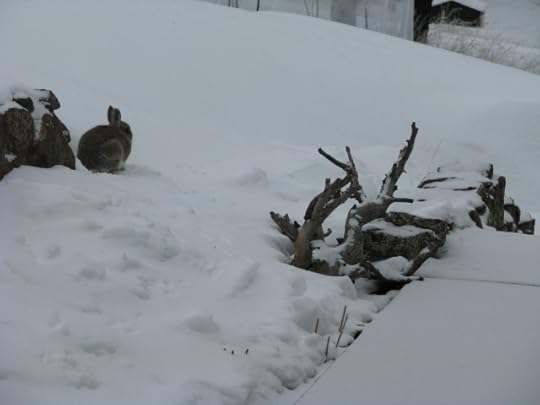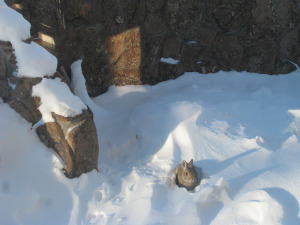Andrea M. Jones's Blog, page 14
July 24, 2015
A Secret in the Garden
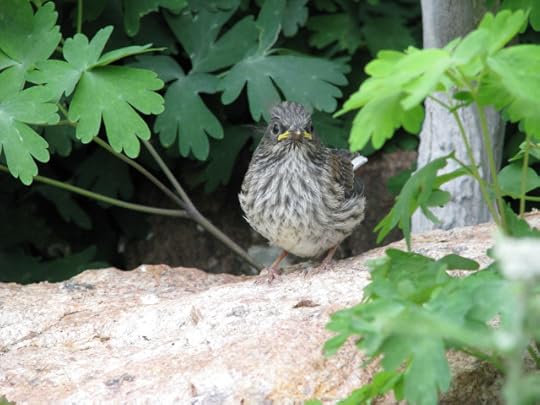
A juvenile dark-eyed junco under the red columbine plant.
One afternoon back in early June, a junco exploded from underfoot when I was in the garden. I didn’t think much of this, even though the same thing happened (in about the same location) a couple of days later.
Dark-eyed juncos are common up here. Their habits keep them close to the ground where I’m likely to see them. After many years, I recognize them automatically, whether by their plumage (gray with a rust-colored back and bright white bars along either side of their tail), or by their peeping chatter. I think the birds might regard me more favorably than most of our wildlife neighbors do, since a number of my activities create feeding opportunities. The slightly pudgy birds like to forage in the garden, and a small flock is usually in attendance when I feed the horses in the winter, ready to clean up dropped grain and pick through the hay for seeds. I admire the juncos for over-wintering up here, and one of the small perks of plowing is seeing them converge on the ribbon of dirt behind the pickup, scratching for seeds.
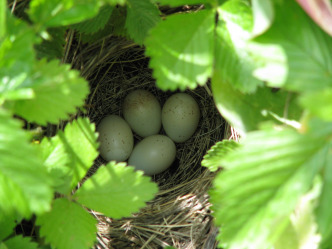
And then there were four.
The junco in the garden didn’t elicit a second thought, then, until I was looking for strawberries in the patch in the northwest corner of the garden and uncovered an elegant cup of grass. Duh. The junco was building a nest when I disturbed her work.
I was afraid I might have forced the little gray bird to relocate her efforts, but two days later I peeked in, and the cup contained a pretty egg, delicately peppered with rusty flecks. The next day there was another. And the next day, still another. Finally, there were four.
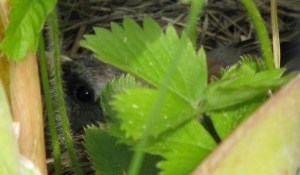
Look close, to the left of the strawberry leaves: the bright eye.
I tried hard not to be a pest, but this opportunity to glimpse the domestic life of one of my neighbors was just too much. I reasoned that the birds knew what they were getting into when they chose their site: that they’d accepted my bumbling but intermittent presence as a reasonable trade-off for the garden walls’ protection from wandering deer, elk, cows, coyotes, and other potential marauders. I started sneaking over to that corner of the garden to check in after feeding horses and recording weather information. If a junco was on the nest—stock-still, its glossy eye, unblinking, on me—I would creep away. But if there wasn’t an adult on the nest, I’d part the covering canopy of strawberry leaves and admire the little eggs. After about two weeks, I peered in to find the pale smooth ovals replaced by blobs that looked for all the world like wads of pink bubble gum that had been dropped in dark gray lint.
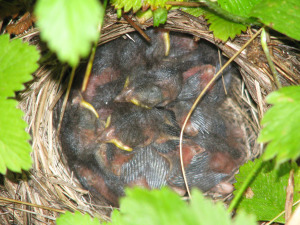
Count the beaks: still four.
Within days, the airy fuzz began to yield to itty-bitty feathers laid out in neat lines showing that certain of the now-bony lumps were destined to become wings. Yellow beaks in the shape of a curly bracket—}—marked other lumps as heads.
It wasn’t long before the nest was starting to overflow with rapidly growing baby birds. After a little over a week, I decided the birds must be indifferent to my snooping, and started to look for strawberries under the plants next to the wall, a few feet from the nest. A strawberry plant emitted a plaintive and accusing “Pweeep!!” and a little gray bundle scrambled out from under my reaching hand. I decided I’d best sacrifice the berries in that corner until the kids had flown the coop, lest I step on someone.
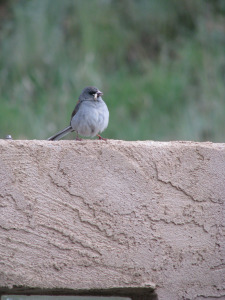
Dinnertime.
Like the three sets of bluebird parents raising broods in the nest boxes around our place at the same time, the junco parents were kept busy. They’d arrive on the wall with a white grub, check the perimeter, and swoop down, clicking to the babies, who clicked back at them, shoving at one another to get to the front of the chow line. The other parent, which I couldn’t help but think was the male, favored the chimney cap as a lookout, keeping watch as babies hopped around and begged. The nest, outgrown, was abandoned for the playpen of the strawberry patch, the rhubarb, and the dense thicket of the red columbine in the southwest corner.
About two weeks after the eggs had hatched, I was lurking in the garden hoping to snap some baby pictures. The clicking chatter between the adult up on the wall and the babies hidden in the garden’s greenery was like a Geiger counter in a radioactive hotspot. One little bird hopped out of the cover of the columbine plant and, after snack from mom’s beak, abruptly purred upward and over the wall, the sound of its stubby wings calling to mind a toy airplane powered by a twisted rubber band.
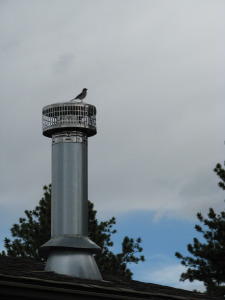
A parent on lookout: surely that’s a dad thing?
By the next afternoon, there was only one youngster still inside the wall, and the adult junco on feeding duty (Mom, in my mind) seemed exasperated. She brushed in front of me as I entered the garden, her rapid clicking sounding to me like a scold. I figured I should leave the family to their affairs, and left as soon as I could—though maybe she was hoping I’d make a run at the kid and chase it over the wall.
The next day, there were no baby birds hopping around between the vegetable plants, no adult birds bustling and calling from above. Quiet has settled back over the planting beds. I don’t have to watch where I’m putting my feet. I’m free to pick strawberries wherever and whenever I want. The garden is serene, but maybe just a little bit lonely.
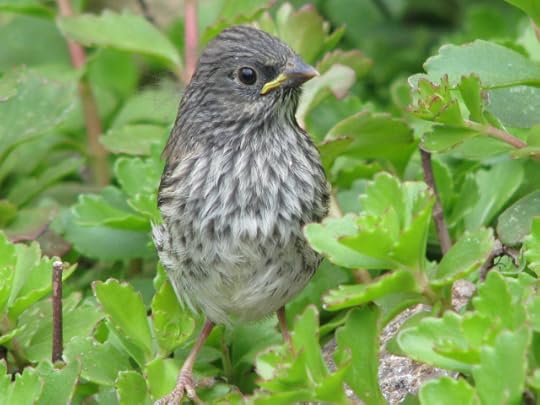
Damp from the sprinklers.


July 5, 2015
Fireworks Underfoot
Impressive rains in early May gave everyone in this region plenty to talk about. Water accumulated in places it hasn’t been seen in years, if not decades. Springs sprang back to life, and long-dried-out seeps began weeping once again–presumably from joy. Rivers, streams and creeks raged. Lakes, ponds, and reservoirs brimmed, and overflowed. Roads flooded.
The water has subsided, but its legacy lives on in grass, a marvel of green spread over the landscape, persisting, now, with the onset of summer thunderstorms.
The flowers have been coming on gradually, but by now the only way to describe their abundance is to call it an explosion–or millions of them: spangles, sparks, sprays, and bursts. Everywhere I turn there’s a new arrangement: a glorious carpet here, a simple bright stem there, an unexpected color combination around the corner. The blossoms banner in the foreground and flutter demurely in the background. Still more are waiting in the wings: many of our most prolific and reliable native plants are still biding their time for a high summer showtime.
The variety and abundance make me dizzy. I’m in awe every time I walk outside or look out the window. So, in honor of the recent Fourth of July weekend, I put together a slideshow to share some of the botanical wealth. If a picture is worth a thousand words, this is my longest blog post to date. I apologize in advance if the images take a little time to load, but I hope you enjoy the show.
Click to view slideshow.


June 9, 2015
Running Late, Right on Time
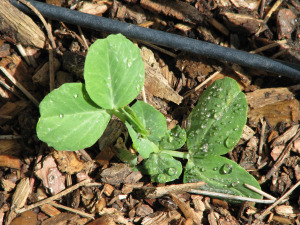
A snow pea seedling, dwarfed by the trellis.
Annual cycles come in every variety, and my yearly gardening procrastination routine is well underway.
Every year, in the doldrums of “spring” promise during March and April, I vow that THIS YEAR I’ll get the garden put together in a timely fashion. This pledge seems eminently reasonable in those months when the weather is too cold and unsettled to do anything other than fantasize about growing things. I’ll get seeds started inside, I think to myself, six to eight weeks before the last frost, just like the seed packets advise. I’ll tuck the seeds for early season crops in chilly soil, well before the rest of the garden goes in around Memorial Day. I’ll get the pots planted up with bright bedding plants while they’re still in the greenhouse, so they can settle in and fill out before I haul the pots up to the decks to grace our outdoor spaces with color and botanical perfume.
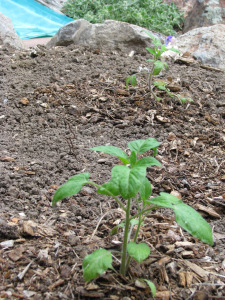
Young tomato plants, settled in for the summer.
I’ve yet to hit all those goals. May inevitably brings a pileup of chores or travel, and I wake up one day realizing that I’ve once again managed to shorten our already-stunted growing season by planting the garden later than I should. I berate myself for my procrastination.
Still, the garden almost always forgives. And it may be that the eagerness of plants to embrace their destiny and simply GROW is what allows me to harbor my secret theory: that delay and inefficiency pay off about as often as they trip me up. In third-case scenarios, I suspect, the results are a wash.
This year’s garden will be a mash-up of proactive enthusiasm and “I am late, I am late.” I got my act together enough to start some seeds in early April. The squash was a total bust and the eggplants are sickly, but I ended up with seven nice tomato plants. I didn’t kill them while hardening them off, as is my usual habit, and they appear to have survived transplanting, too. These are all short-season seed varieties I got from Penn Parmenter, so I’m hoping their Siberian vigor is a good match for my high-altitude location.
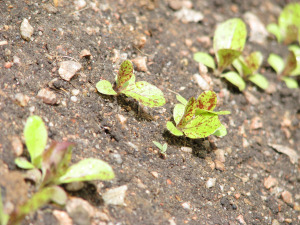
Flashy Trout’s Back lettuce.
I also got some early season crops planted, well, early. Pea, fava bean, and Brussels sprout seeds went in the ground at the end of April. Frequent (and I do mean frequent) rain kept the seed beds wet with no effort on my part. The weather was so cold, however, that I was beginning to think my industriousness would actually be punished. When there were no visible signs of life in the pea patch or the fava rows after almost four weeks, it was looking like the advantages of procrastination would be proved. The sun finally came out in early June, and bright folded leaves soon broke the surface of the soil. The plants are now vigorously making good on their head start. The lettuce, beets, and onion sets I planted a few weeks later are also up, although not yet running.
For everything else—for the carrot, chard, bok choy, bush bean, and mustard green seeds; for the seed potatoes that have been sending out their hopeful sprouts for weeks already; for the flowers for the pots and the replacement squash plants I have yet to buy—it’s business as usual. Memorial Day came and went. A week passed, and then another. Once again, I’m hustling to get everything done before the middle of June rolls around.
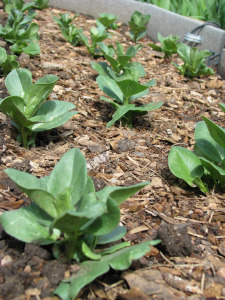
Enthusiastic fava beans, already scarred by hail.
I always watch the garden develop with hungry interest, but I’ll be paying special attention to the tomatoes and peas this summer. If they flourish, they’ll be doing more than just cheating a couple of growers down at the local farmer’s market out of a few bucks: they’ll be scoring points in favor of go-getter-hood. Not that I’m rooting against the crops that got a timely start, of course. I’d be a fool not to welcome another bumper crop of snow peas and homegrown tomatoes for salads and homemade salsa.
But I’ll be watching those carrots and potatoes with just as much interest. I’ll be cheering all those late-planted plants on in hopes they’ll support my theory that, in gardening at least, the penalties for procrastinators are light.


May 15, 2015
Just One Storm
I’ve lived in a semi-arid environm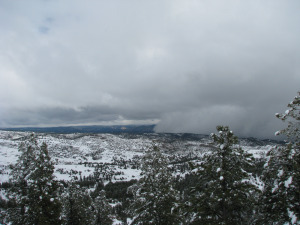 ent all my life (except two years during college when I lived in England: a wonder of green, and skin that did not demand a daily slathering of lotion). Living where the air is perched perpetually at the edge of parched, my default setting is to welcome both the idea and the actuality of wet weather.
ent all my life (except two years during college when I lived in England: a wonder of green, and skin that did not demand a daily slathering of lotion). Living where the air is perched perpetually at the edge of parched, my default setting is to welcome both the idea and the actuality of wet weather.
Our precipitation, whether snow or rain, most often comes in dumps rather than in steady offerings. Sometimes it “rains” or “snows,” but more often moisture arrives with stormy accompaniments: blizzards with whipping winds, thunderstorms with zinging flashes and house-rattling thunder. One offshoot of this propensity for the weather to arrive in extreme bursts is that a single weather event can completely change my outlook for a month, or for a season.
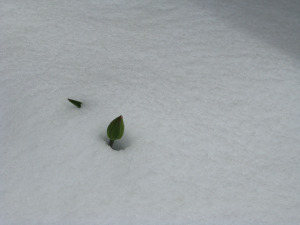 After a snowy late February, March, which is normally one of our wettest months, ran dry until the 18th, when a storm system brought fog, then rain, then heavy wet snow. I keep track of precipitation, and this single storm tipped the balance, transforming March from dry to average.
After a snowy late February, March, which is normally one of our wettest months, ran dry until the 18th, when a storm system brought fog, then rain, then heavy wet snow. I keep track of precipitation, and this single storm tipped the balance, transforming March from dry to average.
After one little blizzard-y burst a week later, the weather turned dry and warm again. Then the wind started blowing. The gusting and blasting seemed to be seeking out any dregs of moisture that might be lurking in the landscape. When a fire broke out about ten miles northeast of our place (yes, folks, cigarettes tossed out of cars really do start fires), that snowy weather back in February seemed like a distant dream and I was starting to brace myself for a long summer of high fire danger.
Another spring snowstorm finally formed up in mid-April. The snow melted as it fell initially, so the accumulation was hard to gauge. By the end, though, the ground had gulped almost an inch and a half of moisture. April, like March, abruptly had some respectable precipitation to show for itself, and desiccation was held at bay. The bulbs in the garden celebrated with an exuberant surge.
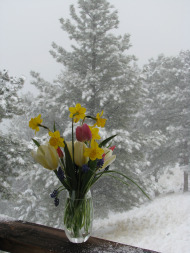 When snow turned up in the forecast again ten days later, I cut some of those flowers so we could enjoy a little springtime indoors while winter raged outside. The sloppy dump of slushy snow added up to another 1.4” of precipitation. All of a sudden we had the wettest April since I began keeping precipitation records in 2006.
When snow turned up in the forecast again ten days later, I cut some of those flowers so we could enjoy a little springtime indoors while winter raged outside. The sloppy dump of slushy snow added up to another 1.4” of precipitation. All of a sudden we had the wettest April since I began keeping precipitation records in 2006.
Just one storm: I started thinking what a difference that one storm can make, both in my attitude and in the appearance of the landscape outside the windows. The snow melted, the grass made another surge. The tulips, muscari, and daffodils romped more enthusiastically. I could smell the sap rising in the pines.
My satisfaction with my “just one storm” theory was short-lived. A monsoon-like pattern of thunderstorms set in on the first day of May, and since then we’ve only had two days without any rain.
May 2015 is already the wettest May on my chart of precipitation recordings. I’ve gone back to my old theory about the weather up here: there is no “typical.” Every month, every year, plays out differently. The weather here resists regular patterns. I’ll decline to predict, and merely observe.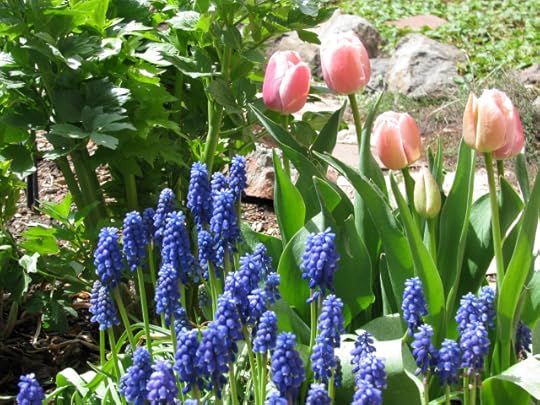


April 13, 2015
The Slowest Season
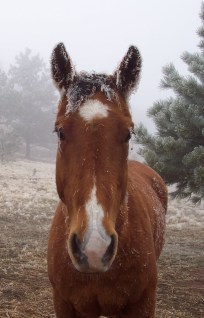
April frost.
That spring doesn’t arrive early here, 8900 feet up in the Colorado Rockies, probably seems self-evident. I’m in the habit of saying that Groundhog Day is a worthless barometer for the changeover from winter to spring, because in my experience winter simply doesn’t end in February. If I adjust my expectations, though, and stop focusing on winter’s end or spring’s arrival, things are less cut-and-dried. Our last frost date might be in late May, but it’s not pure delusion to begin watching for signs of spring in February. And then keep watching, because the signs keep coming.
The earliest evidence that winter isn’t permanent emerges when we’re still likely to get severe winter weather. Between surges of arctic temperatures, smooth yellow-tinted ice bulges up from the snow (or, in dry years, from the dessicated ground) in certain spots, revealing the locations of sub-surface springs.
Also in February, our horses start shedding their long guard hairs, the sparse threads that fluff beyond their dense winter coats. The shedding is triggered by longer days and the horses can’t do anything about it, but I always tease them that they’re going to want those winter coats for a while yet.
I usually start seeing mountain bluebirds kiting in the horse pasture on sunny days in March, although I spotted one this year on February 10, the day before a three-week run on intense winter weather kicked in. The bluebirds are just day-tripping to start; they won’t get serious about claiming one of the nest boxes on the fence line for six or eight weeks.
By mid-March, the lengthening days and gradually rising temperatures start warming the ground. On the local gravel roads, snow melts as it falls, creating mucky tracks instead of flawless white ribbons. Once the snow starts sticking, it’s challenging not to plow the top layer of gravel road base off along with the snow.
Those lengthening days also put passive solar gain into overdrive inside the house, with low-angle sun pouring through the south-facing windows until I close some blinds or open a window for a few hours to moderate the heat.
The winds will gust in days-long blusters in March or April, sublimating the moisture out of crumbly snowdrifts and drying the brief surge of mud to dust. The ponderosa pines sway desperately in the aggressive air, as if trying to uproot themselves and move someplace more serene. For a few days, a haze of dirt blown in from the desert Southwest will fuzz the view, screen the distant peaks.
Now, in the second week of April, we’re seeing and hearing and smelling the classic milestones of springtime: currant bushes swelling with buds, miniature cinquefoil leaves unfurling in the dark brown crinkle of last year’s growth, robins singing, Northern flickers hammering their seductive rhythms on dead trees and metal chimney caps, pine sap perfuming the evergreen woods with a spicy scent. Scattered like Easter eggs left in undisguised hiding places for the littlest kids, the fuzzy lavender cups of pasque flowers decorate th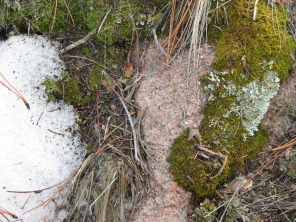 e still-dormant grass, where a tint of green is beginning to show from underneath. On the shady north-facing slopes, plump pads of emerald-green moss glow in the chilly dampness left by receding snow.
e still-dormant grass, where a tint of green is beginning to show from underneath. On the shady north-facing slopes, plump pads of emerald-green moss glow in the chilly dampness left by receding snow.
And so it will go, in this slowest of the seasons: each species budding or flowering or nesting according to ancient patterns. A sequence of seasonal “firsts” each taking a turn with seeming deliberation.
Summer and winter arrive with weather-forecast fanfare—heat and thunderstorms; frost, snow, and blizzards. Fall seems to start and conclude on a tighter schedule than spring—or is it just that I don’t notice all the nuances of senescence when they start in August and proceed through the hard freezes of November? Autumn is a slow release, a time for making note of details, rather than actively seeking them out.
By midwinter I’m on alert—desperate, sometimes—for signs the universe hasn’t gone off its rocker and the winter will, indeed, eventually, come to an end. Is that the difference, then? Do I think of spring as the slowest season because it is, high up here in the temperate zones, the time of year when I am demanding newsworthy events from my surroundings? Because I am wheedling the grass and the trees and the animals for reassurance that the warmth and vitality and the bustle of summer are at hand, or soon will be?
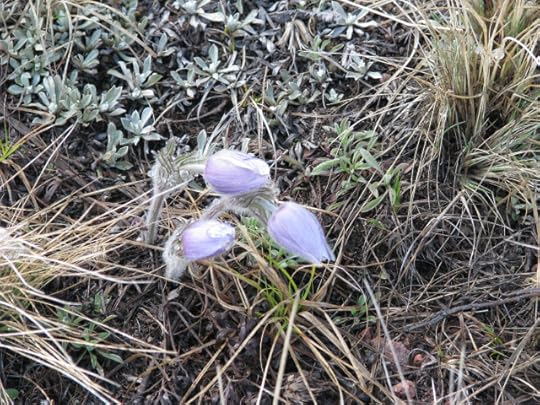
Pasque flowers.


April 3, 2015
Local Events: Helicopter Training Proposal
In a bit of a change of pace, I’ll refer you today to a piece titled “Change in the Air” that I wrote for Writers on the Range, an Op-Ed syndication service of the publication High Country News.
The US Army base at Fort Carson, the western boundary of which is a little less than thirty miles east of my home place, has submitted a proposed Plan of Development to the BLM (Bureau of Land Management), requesting a Right of Way to use 43 parcels of public land as helicopter landing sites. Landing exercises are just one aspect of “High Altitude Mountain Environment Training,” or HAMET, however. Flight training exercises, as low as 25 feet above the ground, would be allowed over tens of thousands of acres in south central Colorado. This would be a helicopter training site for all branches of the military, not just the Army. The plan calls for thousands of helicopter flights per year.
If you live, hike, ride horses, bike, hunt, raise livestock, camp, or rock climb in the area, or know anyone who does, please spread the word. Not many people seem to know about the proposal. The BLM is accepting comments on their scoping report until April 10, 2015.
You can view documents related to the Army’s proposal and the BLM’s evaluation process at blm.gov/23ld.


March 17, 2015
Home, New-Old
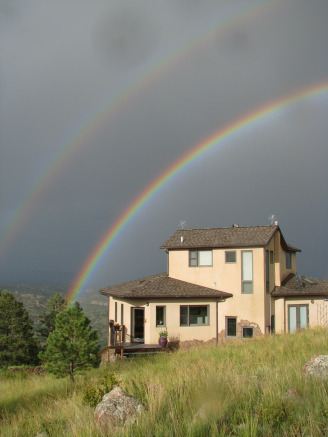 We moved into this house back in March, 2003, twelve years ago this month.
We moved into this house back in March, 2003, twelve years ago this month.
Which, when I think about it, is longer than I’ve ever lived in any other house. If I do the math, it turns out I’ve spent just shy of one-quarter of my life occupying these rooms. Add in a couple of years worth of thought and planning and about nine months of building, and this house has been the hub of my existence for a substantial portion of my life.
For me, statistical curiosities like this tend to flare pretty briefly on the “Interesting” scale: Huh. I’ll be darned. And then my brain is off looking for something more…amenable to interpretation, I suppose. Less conclusive. More quirky.
Such as this: Given that I’ve lived here longer than in any other home, why do I persist in calling this our “new” place when talking to people who have known me for a long time?
In part, that’s a term of descriptive convenience: our “new” place, in central Colorado north of Cap Rock Ridge, is not to be confused with our “old” place, the house in Fourmile Canyon west of Boulder that Doug and I lived in before we moved here.
The temporal-geographical explanation has just enough basis in reality to be plausible, but there’s something else going on. The psychology of this persistent “new” isn’t rooted in the word’s connotation of recentness. I’m pretty sure my skewed vocabulary is trying to voice a different truth, one in which newness pertains to that which is uncharted and fresh.
When we moved here in 2001 to begin building the barn/cabin we would live in before we built the house, I arrived with a plan. I had in my mind a writing project called A Year at Home, which would chronicle our transition from the urban margins of Boulder to this rural property. I would write about my explorations of my new home place, would reflect on discoveries and challenges with a focus on natural history observations. I wasn’t naive enough to think that it would only take a year to compile the observations that would anchor the narrative, but I envisioned the annual cycle as an organizational device.
As we settled in and began to set up our new lives and rhythms, I made a commitment to paying attention to what was going on around me. I stuck to that goal as best I could, watching the weather, the birds, the deer and chipmunks. I smelled wildflowers and mud and dried grasses and smoke from wildfires. I listened to the wind and to the ravens and to cattle and to the lusty wailing of bull elk in the fall. I observed the landscape and the sky in different seasons and shades of light, in dry years and wet ones. I kept a journal, made notes, continued hold myself to the expectation that paying attention in preparation for writing about my surroundings was part of my job—alongside supervising construction workers, establishing a garden, and improvising a working-life dance with my husband so we could support the whole endeavor financially. When the contractors left, we did finish work on the house and then plugged away at masonry and landscaping, projects that stretched for years. We entered into an annual round of chores: maintaining the garden, cutting firewood, hauling hay, plowing roads, pulling weeds.
Throughout and in between, I kept at my original job, looking up from my desk now and again to check the view out the windows. When I was outside, I tried to stay alert for the notable, whether I was working or walking or riding. The year at home stretched to a near-decade. After struggles, fits, and re-starts, I assembled a scrawny manuscript. The one-year structural device seemed absurd by then, so I renamed the project The View from Home. Another four years later, slightly plumper and now titled Between Urban and Wild, the book came out. I had, finally, made good on my plan.
I kept my old job, though, as a self-employed observer. As I enter the thirteenth edition of my year at home, I keep hearing and seeing and smelling nuances I hadn’t noticed before, finding my place, perpetually, anew.

February 23, 2015
The Conundrum of Cute
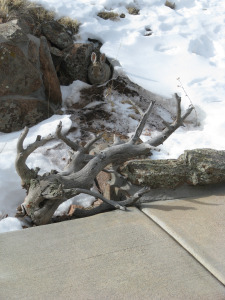 The cottontail rabbit I mentioned a month ago is still around.
The cottontail rabbit I mentioned a month ago is still around.
When I didn’t see it for a few days and the entrance to the burrow near the front walk stayed covered with snow, I assumed it had met with the usual fate of bunnies around here, becoming dinner for a coyote or an owl. Then one day the burrow entry was open again, and soon after I started seeing the rabbit, dozing on its front stoop in the evenings.
The burrow is close enough to the hall window and front door that I can see the rhythmic twitching of the rabbit’s nose pause when the animal is alert to me, but the freeze behavior doesn’t usually last long. The rabbit has grown blasé about our movements in the house ten feet away. It could turn tail and scurry in its front door when I walk out of mine, but it doesn’t. I’ll admit I’m generally amused to see it.
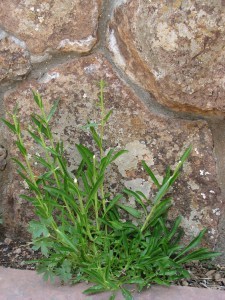
Can’t see the pretty purple flowers of this penstemon? That’s because an unknown rodent cropped off every single stem.
This is not normal behavior for me.
Usually, I am intolerant of rodents. Having suffered persistent losses to my landscaping efforts for more than a decade, I’m jaded with regard to small mammals that nibble and gnaw. I’ll dash out the door shrieking when I see a chipmunk or ground squirrel or rock squirrel near the house. When I see a cottontail rabbit, I usually rush it with my arms waving over my head, yelling “Predator! I’m a predator, you little s**t!!” Going to fetch the camera is not my standard response.
My tolerance of this cottontail is a seasonal thing. I know it was attracted, in part, by the forage of my landscaping plants available on its doorstep, but it’s been a snowy winter and I’m having a hard time begrudging the fuzz ball some dormant thyme and veronica when the damage to the plants isn’t glaringly obvious. I couldn’t help but find it adorable when I watched the rabbit wiggle its butt into in a low snowdrift to create a sheltered hollow from which to nosh on a spray of bunchgrass stems.
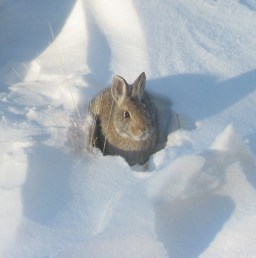 I’ve been indulgent of our little neighbor, too, because rabbits don’t tend to last long around here. They turn up regularly near the barn, arriving as young ‘uns just out on their own, not much bigger than a hamster. They sprint to shelter under the horse trailer. They daintily munch on dropped hay (and at my ornamental wildflowers). They get used to my comings and goings, to the point where I can get within a few feet of them. Then, one day, they’ll be gone, usually before they’ve reached adult stature. Occasionally, I find a tuft of fur or a bony little foot on the ground. I have come across more than one cottony tail.
I’ve been indulgent of our little neighbor, too, because rabbits don’t tend to last long around here. They turn up regularly near the barn, arriving as young ‘uns just out on their own, not much bigger than a hamster. They sprint to shelter under the horse trailer. They daintily munch on dropped hay (and at my ornamental wildflowers). They get used to my comings and goings, to the point where I can get within a few feet of them. Then, one day, they’ll be gone, usually before they’ve reached adult stature. Occasionally, I find a tuft of fur or a bony little foot on the ground. I have come across more than one cottony tail.
In this season of stillness and cold, the cute factor has won out. I’m willing to leave harassment and death threats to the owls and coyotes, for now. What I’ll do if the bunny next door survives until spring—or if a horde of babies joins it in enjoying the evening tranquility one day—I haven’t decided.

February 2, 2015
Moondo’s Project
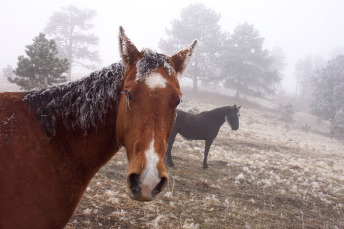
Down in the sheltered terrain of the Barn Pasture…but not happy about it (that’s Max, Moondo’s former buddy, in the background).
Moondo, my little bay horse, is the most opinionated equine I’ve ever met. This isn’t to say that he’s mean or obstinate or flighty, just that he has strong ideas about how his universe should operate. Ego and a dainty appetite are behind a few of his more maddening behaviors, but his principal preoccupation is with his field.
Property lines and roads dictated our fence layouts, resulting in two small enclosures and one big one. The Barn Pasture, on the north side of the driveway, adjoins the barn. The Long Pasture on the other side of the driveway is, as you may have surmised, long and skinny. The Big Pasture consists of 35 acres, encompassing the top of a broad drainage where the ridge west of our house splits into two fingers.
The attraction of the Big Pasture, in Moondo’s mind, has less to do with size than with sightlines. Trees are scarce and the geography is such that pretty much the entire field is visible from inside the perimeter. There’s thick meadow grass at the Barn Pasture, but the ground swoops low between two shoulders of land and it’s surrounded by ponderosa pine and rock outcrops. It’s sheltered in winter, which I consider a plus, but Moondo disagrees with my logic. He likes to keep tabs on his surroundings and seems to be impervious to inclement weather. He hates the Barn Pasture, and is annoyed that I insist on feeding at the barn in winter.
In the mornings, and in spring and fall when the weather is more mild, we feed hay at the end of the Long Pasture, near the gate leading into the Big Pasture. Accessibility makes the spot convenient, but it’s pretty exposed, so we built an open-bottomed box out of leftover deck planking to keep hay from blowing away. The box is tough, weather-resistant, and heavy enough that it stays put. Unfortunately, it’s not big enough to prevent a big and food-aggressive horse like Moondo’s pasture-mate, Jake, from hogging the contents, so we split the hay ration and put Moondo’s share in a galvanized metal water tank a short distance away.
I’m not sure if flipping the tank started as a way to make it easier to glean the tastiest bits of hay, or because eating out of the tank feels claustrophobic, but flipping the container has become quite the thing with our horses. Now they don’t just flip it to dump hay, they also bang the tank back and forth when they think more hay should be forthcoming. Now.
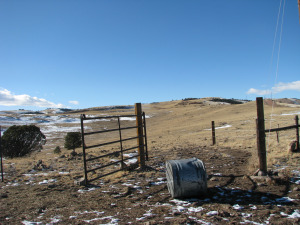
The hay tank headed for the Big Pasture.
At some point last fall, Moondo had an epiphany. He made a connection between flipping the tank and its position in the field, and started rolling the tank up the hill a few rotations every day. I knew he wanted to be higher up so he could see down into the Big Pasture, but I wanted the tank lower, where it would be somewhat out of the wind, so I would pull it back down. The next day we’d do the same thing. Eventually I decided to see where he’d go with this project, and stopped repositioning the tank. I was pretty sure his aim was to get it out into the Big Pasture.
After a few days, he got the tank up to the crest of the hill, then spent a few more days trying to maneuver it under the fence. That would require lifting the lowest strand of fence wire and pushing at the same time, however. Given his lack of opposable thumbs, Moondo settled on a new tactic and started directing the tank toward the gate. He’s smart, but engineering is a new discipline for him, and positioning a four-foot-long oblong tank to roll sideways through an eight-foot gate proved tricky, especially given that the ground is rocky and uneven. He did manage to get the tank far enough to block the gate opening a couple of times, but at that point I decided he’d never quit if he did get the thing out into the Big Pasture, so I started pulling the tank back where I wanted it. In the spirit of compromise, I let that spot be at the top of the hill, where Moondo can look down into the Big Pasture as he eats.
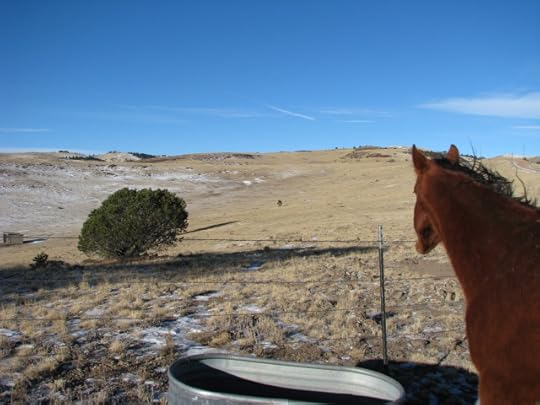
Breakfast with a view.
And that’s where things are now. The tank isn’t stationery, but attempts to get it out the gate have been half-hearted. Moondo seems to be satisfied with the view from his breakfast table.
I’m glad he’s s found a way to exercise self-determination that doesn’t involve obnoxious behavior. And since he’s figured out how to adjust the tank’s position, I figure it’s now up to him to move it—or not—when a gale is belting over the land and whisking hay from between his lips.

January 20, 2015
The January Plan
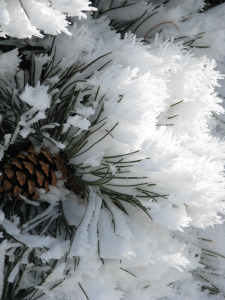
Not snow: hoarfrost, following a day and a half of fog.
I’ve been looking forward to January since November. Back then, I’d realized that the writing project I was working on had gone wildly off course. Although I knew it had made a wrong turn, I didn’t have the time or energy to chase after it. January, I figured: I’ll get back to it then. It can shiver in the wilderness for a while.
In my imagination, January was the ideal season for settling in and allowing my attention to wander inward. The cold and wind typical of midwinter makes being outside not-so-unpleasant, while fires in the fireplace and tea in the pot generate contemplative coziness. January: I would mount an expedition to rescue my project, get it back on its feet and, if not marching, then at least staggering in the right direction.
Ultimately, writing succeeds or fails on the basis of ass-in-the chair discipline, but there’s something about the endeavor that begs for ritual and structure. I suspect this is because there’s usually something physical about those rituals or structures, something of a reference to the matrix of embodied existence. Discipline, like writing, relies on mental effort, but matters of cerebral bubbling are deceptive. While the brain can get the fire going, the energy for sustained simmering requires fuel from the external environment. The talismans of ritual—I can only write in the morning; I can’t work without the notebook/computer file where I started my notes; I do my best work at the coffeehouse; my lucky pen is out of ink; I don’t have any more organic/rooibos/hibiscus/green/oolong tea—are beacons, however faint, that keep us from wandering too far into the thicket of our interior wilderness. We rely on these amulets too much at times, forgetting to detach from their supposed powers and to start drawing on our own disciplinary batteries again. Routines and mantras, though, serve as touchstones that help keep us oriented toward the sustaining environment outside ourselves.
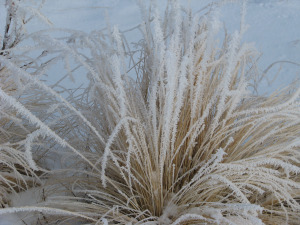 The whole point of writing is to make connections with other human beings. The words cannot function in public if they’re mired in the vortex of the author’s singular experience. Since discipline is part of the interior ecosystem, it’s vulnerable to the pull of the whirlpool of self-reference. The drive to write sometimes creates the urge to shut out the world as a source of treacherous distractions. This only accelerates the spin into a tighter spiral, though, distorting the brain’s energy so acutely it deflects into a black hole, a place where the desire for words falls endlessly in while nothing ever emerges to see the light of a reader’s eyes.
The whole point of writing is to make connections with other human beings. The words cannot function in public if they’re mired in the vortex of the author’s singular experience. Since discipline is part of the interior ecosystem, it’s vulnerable to the pull of the whirlpool of self-reference. The drive to write sometimes creates the urge to shut out the world as a source of treacherous distractions. This only accelerates the spin into a tighter spiral, though, distorting the brain’s energy so acutely it deflects into a black hole, a place where the desire for words falls endlessly in while nothing ever emerges to see the light of a reader’s eyes.
This is probably why writing deadlines are so motivating for so many of us. A deadline is an emissary from the outside world. It disrupts the circular flow with the obstacle of editorial expectations. Retreats and conferences and workshops work in a similar way, breaking the pull of the vortex with a surge of energy from the social domain. On a smaller scale, reading or going for a walk disrupts the rotation, giving the brain a nibble of sustenance from the outside world. We’re biological beings. Without food and water from the environment beyond our skin, we wither and die. The brain evolved as an organ of interface between the inner domain and the outer one. Without input from the latter, it simply cannot function.
Exterior influence, outside energy. This line of thought cautions me against getting too enamored of my January writing fantasy. Lucky me, then, that the spell of interiority is so regularly and so thoroughly broken. There’s the writing, yes, but there’s also the lure of an unseasonably warm January day, replete with sunshine and scarce of wind. There’s the dead battery on the truck when plowing needs to be done. There’s hoarfrost sending out glittery daggers, begging to be admired. There’s lentil soup that wants making. There’s horses to be fed, books to be read. There’s the cottontail rabbit that’s made its home in a burrow next to the front walk. And there’s the writing.


